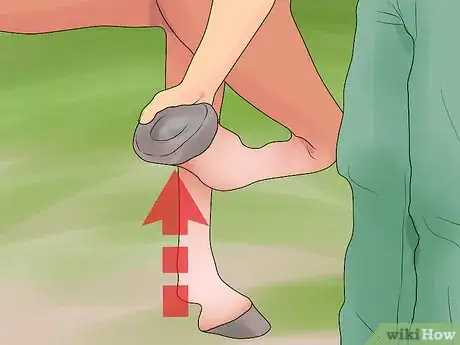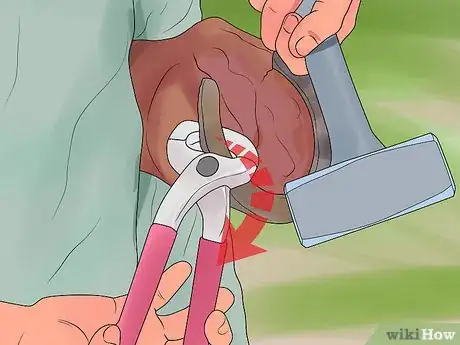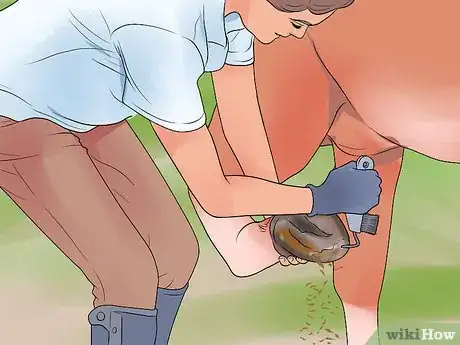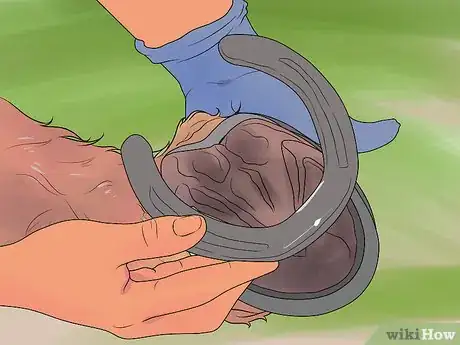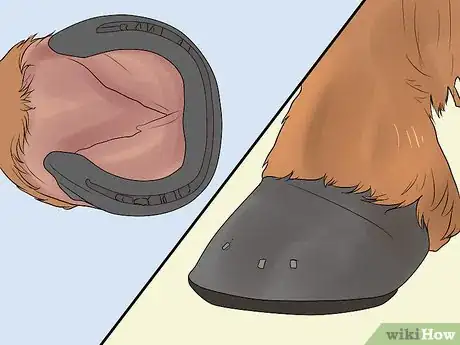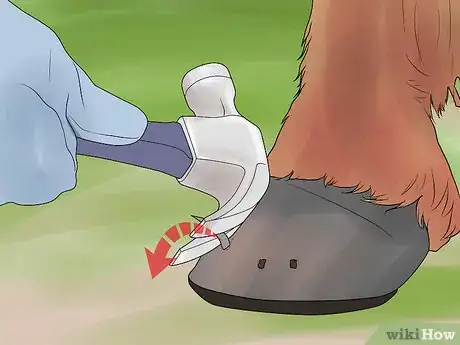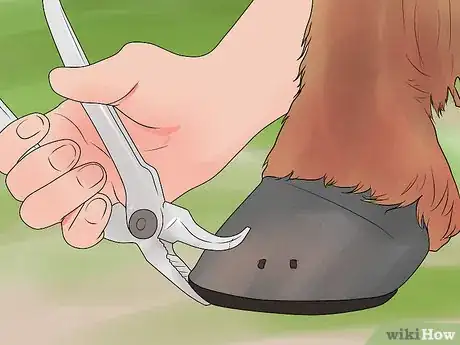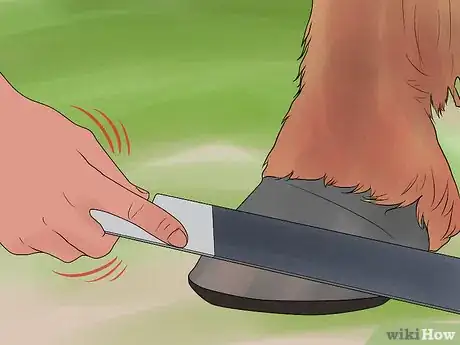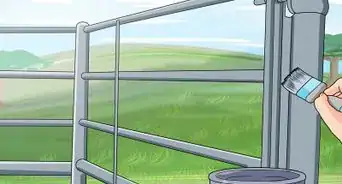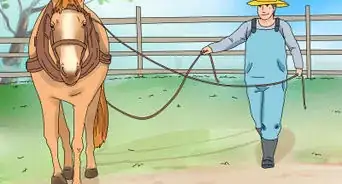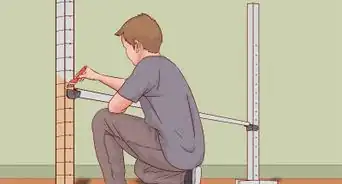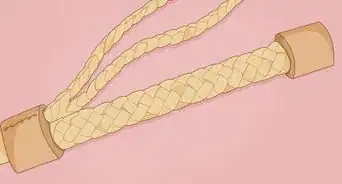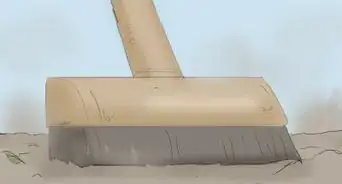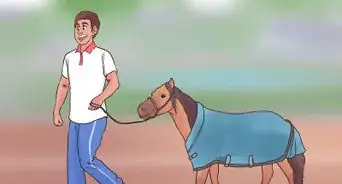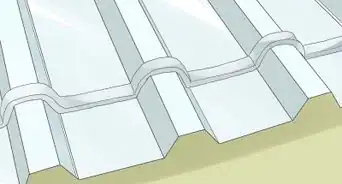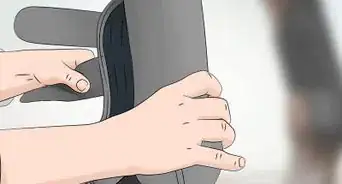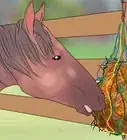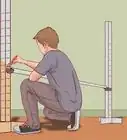This article was co-authored by Kate Jutagir. Kate Jutagir is an Equestrian Specialist, Hunter/Jumper Trainer, and the Owner of Blackhound Equestrian, a premier training barn located on 65 acres in Castro Valley, California. Originally designed to be a riding school used as a springboard for dedicated students into careers in the sport, Blackhound Equestrian has grown into a hunter/jumper training program for all levels focusing on providing a solid foundation needed for personal advancement in the sport. Kate has over 25 years of equestrian instruction and training experience. Her focus on developing horse and rider partnerships provides a complete equestrian education for both beginners and advanced riders alike.
wikiHow marks an article as reader-approved once it receives enough positive feedback. In this case, 91% of readers who voted found the article helpful, earning it our reader-approved status.
This article has been viewed 185,983 times.
While wild horses can roam for miles each day without any form of protection on their hooves, domesticated horses require regularly-maintained horse shoes to protect their feet from injury and boost their effectiveness as work animals. People trained in the art of horseshoeing are called farriers. Learning the basic skills of a farrier is a smart idea for any horse owner. Because horse shoes need to be replaced every four to eight weeks, the cost of hiring a professional farrier every time can soon run rather high. If you want to learn how to shoe a horse yourself, make sure that you have a trained farrier teach you how. Do not attempt to shoe a horse for the first time without the help of a trained farrier! Keep reading to learn about the process of shoeing a horse.
Steps
Preparing a Horse's Foot for Shoeing
-
1Lift the horse's foot. When working with a horse’s hooves it's important to move the horse's foot into position in a way that doesn't surprise the horse or irritate it. Make sure the horse is aware of your presence by gently patting it on the rump. To get your horse to lift her foot, run your hand down her leg. Then, squeeze the tendon above the ankle and lift the hoof. The horse should shift its weight to its other three feet.[1]
- While you work, hold the foot in place by tucking your hip against the horse's hock (the large joint on the hind leg) and gaskin (the muscle above the hock). Use the inside of your knee to pull the foot out slightly and up between your legs so that the sole of the hoof faces up towards you. Support the horse's toe with one hand. This position locks the horse's foot in place, making it difficult for the horse to kick or put its foot on the ground before you're done working.
- Make sure that you reward your horse with praise for cooperating and waiting while you clean her hooves. Saying, “good girl” or “yes” after she lifts each hoof for you will help to reinforce your horse’s good behavior.[2]
-
2Remove any shoes that are already on the horse's feet. To remove a horseshoe, first, "break" (straighten) the nail clinches (the bent tips of each nail that holds the shoe on) with a clinch cutter and a hammer. Work the blade of the clinch cutter under the clinch, then hit it with a hammer to straighten the nail. Then, use a pair of metal pull-offs to loosen and remove the shoe. Close the jaws of the pull-offs around the outside heel of the shoe and use an outside to center rocking motion, working towards the toe to loosen the shoe. Repeat for the inside heel and proceed in this fashion until the shoe can be pulled off.[3]
- Several alternatives exist for breaking the nail clinches. In a pinch, you can use a rock and a flat head screwdriver to bend the nail tips upwards, or, if you're careful not to wear a hole in the hoof wall, you can even use a rasp to file the nail clinches away.
Advertisement -
3Clean the bottom of the hoof. For your horse's health and safety, you don't want dirt or debris trapped between its new shoe and its foot. Before shoeing your horse, use a hoof pick to remove any compacted dirt, mud, rocks, manure, etc. from your horse’s foot. Use downward strokes from heel to toe. Follow the hoof pick with a wire brush for added cleanliness.[4]
- Take care around the frog - the triangular portion in the middle of the hoof. This part of the hoof is extra-sensitive.
-
4Use a hoof knife to remove excess, flaky sole from the bottom of the hoof. Typically, before a horse is shod, the dark, hard, outer layer of each hoof's sole is removed to reveal the softer, whiter material underneath in a process roughly equivalent to trimming a human's toenails. Take care not to cut too deep, or you risk hurting the horse or even rendering it temporarily lame - the same as if you'd cut a person's nails too short.
- This process is easiest if you keep your hoof knife razor sharp. But use caution. It's easy to accidentally slip and cut yourself while working.
-
5Trim excess hoof wall with hoof nippers. The hoof wall - the edge of the hoof - should extend about 3 inches (7.6 cm) to 3 & 3/4 inches from the hairline above the hoof itself. If it's any longer, use a set of nippers (essentially giant nail clippers) to trim the edge of the hoof to a suitable length.You should see a ridge where the hoof wall extends beyond the sole. Do not cut into the sole with the nippers, or you may injure the horse.[5]
- When you trim the hoof with nippers, be sure to keep the trimmed edges of the hoof uniformly straight and level so that they'll sit flush with the ground. Trim from each side of the heel to the toe.
- The exception to this is in cases where a horse's gait wears its hoof unevenly - in this case, you'll want to take slightly less hoof material off of the side that the horse favors. Use caution when making this distinction and, if unsure, consult an experienced farrier.
- When you trim the hoof with nippers, be sure to keep the trimmed edges of the hoof uniformly straight and level so that they'll sit flush with the ground. Trim from each side of the heel to the toe.
-
6Use a rasp to flatten and level the the sole. The very last thing that must be done to prepare the hoof for its shoe is to ensure the bottom of the hoof is smooth, flat and level. Use a rasp to gently file any uneven spots on the bottom of the hoof, taking care, as always, not to wear the hoof too short or irritate the frog. Then using your knife, pare away slightly to bevel the sole away from the hoof wall. Contact of the sole on the shoe can cause the horse discomfort.
Shoeing Your Horse
-
1Size the shoe to its hoof. As with human feet, horse feet come in many different sizes and, thus, different horses will require different-sized shoes. Before proceeding, ensure that the shoes you have available are the correct size for your horse's feet. Note that a horse's front and hind feet are differently-shaped, so you will need different shoes for each.most horses have a size smaller in the back then the front, but not always.
- If you have to choose between shoes that are slightly too big and shoes that are slightly too small, choose the bigger shoes. These can be bent, shaped, and ground down to a smaller size, while too-small shoes can't be made bigger. Too long a shoe in front will cause the horse to step on the exposed heel of the shoe and pull it off.
-
2Make minor adjustments to the shape of the shoe, if needed. Often, even if horse shoes are the correct size, they will not fit a horse's foot without adjustments. Like human feet, horse feet can be asymmetrical or uneven. There are several ways to custom-shape horseshoes.
- If you're a knowledgeable metalworker, you can heat the shoe until the steel can be bent to the size of the hoof.
- Or, you can cold shape the shoe on an anvil using a hammer and tongs.
- Some farriers do neither, opting instead to grind their shoes down until they fit with a rasp or grinding machine.
- Well-fitting horse shoes should align well with the edge of the hoof. Keep in mind that it may take some time to get a shoe to the perfect size for your horse.
-
3Secure the shoe in its place with nails. Align the shoe so that it sits perfectly against the edge of the hoof, then drive nails through the holes in the shoe to fix it to the horse's foot. When doing this, care must be taken so as not to hurt or hobble the horse.
- Drive the nail through the hoof at an outward angle so that the nail tips go through the top of the hoof wall.
- Never drive nails into the sensitive inner portion of the hoof. To make this easier, use hoof nails that have a bevel on one side to guide the tip through the hoof wall.[6] With these special nails, the manufacturer's stamp on the side of the nail head should face the center of the foot (towards the frog) - this ensures that the bevel is facing the right direction.
- Some modern horseshoes use glue, rather than nails, to hold the shoe in place.[7] If you're worried about hurting your horse, you may want to try this alternative. Note that application methods for glue-on shoes can vary - consult the manufacturer or an experienced farrier for more information.
-
4Bend and remove the nail tips. Once each nail has been driven, use the claw end of your hammer to bend the tip of the nail over against the hoof wall. Then, twist off the tip or use a pair of nippers to bend and clip the tips off. Try leave about 1/8" of the tip bent over the edge of the hole formed by the nail pointing towards the toe. This ensures that the nail will hold the shoe in place without the sharp tip hurting you or the horse.
-
5Clinch the nail. Set a clinch block under the nail on the outer hoof wall, then set the nail in the hoof (or "clinch" it) by hitting the nail head once again with the driving hammer. This gives the nail a firm grip in the horse's hoof, ensuring the shoe stays in place. You may use a sturdy metal tool, like your nippers, in place of the clinch block in a pinch.
- Another option is to use a special tool called a clincher. With this tool, all you need to do is align the jaws of the clincher over the nail tip and squeeze the handles.
-
6File any rough spots on the hoof wall. Finally, give the outside of the hoof a once-over with a rasp, smoothing out any uneven spots and giving the hoof a nice clean finish. Pay special attention to the clinched nail tips, which can also be filed smooth.[8] When finished, you should be able to draw a cloth over the hoof wall without it catching.
- You may also notice that excess hoof material protrudes over the edge of the shoe. If this is the case, use a pair of nippers or pull-offs to remove it.
-
7Repeat process three more times until all four hooves have been shod. Remember that the front and back hooves will require differently-shaped shoes and that even the two front and back feet may not be perfectly symmetrical with each other.
Community Q&A
-
QuestionWhich way should the nails face?
 Community AnswerThe smooth side of the nail head faces to the outside. This is extremely important, because as the nail is being driven, the tip of the nail will angle toward the smooth side of the nail. If done incorrectly, the nail tip will go into the horse's hoof instead of coming out through the hoof wall, causing the horse a great deal of pain and putting the person shoeing the horse in danger.
Community AnswerThe smooth side of the nail head faces to the outside. This is extremely important, because as the nail is being driven, the tip of the nail will angle toward the smooth side of the nail. If done incorrectly, the nail tip will go into the horse's hoof instead of coming out through the hoof wall, causing the horse a great deal of pain and putting the person shoeing the horse in danger. -
QuestionDoes it hurt the horse when it is shoed?
 Community AnswerNo, the horse cannot feel anything. It is just like when you clip your nails, you cannot feel anything.
Community AnswerNo, the horse cannot feel anything. It is just like when you clip your nails, you cannot feel anything. -
QuestionDoes a horse's hooves grow?
 Community AnswerYes, that is why you need to find a hoof trimmer or a farrier. Always get your horse's feet trimmed every 6 to 8 weeks.
Community AnswerYes, that is why you need to find a hoof trimmer or a farrier. Always get your horse's feet trimmed every 6 to 8 weeks.
Warnings
- Shoeing a horse is best left to someone with experience. It is a dangerous job and should not be attempted for the first time after reading a short web article. You could seriously hurt yourself or severely lame your horse. Please do not attempt this without consulting a professional.⧼thumbs_response⧽
- When shoeing, make sure that you don’t leave any tools on the floor or your horse could step on them.⧼thumbs_response⧽
- Horses do kick, so watch out!⧼thumbs_response⧽
- It's illegal in some countries (such as the UK) for anyone other than a registered or apprentice farrier to shoe a horse.⧼thumbs_response⧽
Things You'll Need
- horse shoes
- horseshoe nails
- hoof pick
- horse nippers
- rasp
- 10-14 oz. driving hammer (for driving and setting nails)
- 6 lb shaping hammer (for shaping the shoe in the anvil)
- pull-offs
- clinch cutters
- hoof knife
- clinch block
- clinchers
- farriers apron
- anvil
References
- ↑ http://www.texasmonthly.com/story/how-shoe-horse
- ↑ https://www.aspca.org/pet-care/virtual-pet-behaviorist/horse-behavior/handling-your-horses-hooves
- ↑ http://www.horsechannel.com/horse-exclusives/pull-a-shoe.aspx
- ↑ https://www.aspca.org/pet-care/virtual-pet-behaviorist/horse-behavior/handling-your-horses-hooves
- ↑ http://www.texasmonthly.com/story/how-shoe-horse
- ↑ http://www.texasmonthly.com/story/how-shoe-horse
- ↑ http://www.dailymail.co.uk/news/article-2287987/Crocs-horses-Plastic-slip-hooves-making-nailing-horseshoes-thing-past.html
- ↑ http://www.texasmonthly.com/story/how-shoe-horse
About This Article
If you’ve never shoed a horse before, it’s a good idea to hire a professional farrier. If you decide to do it yourself, clean the horse’s feet well, and make sure you have shoes that fit the horse’s front and back feet. Align the first shoe so that it sits perfectly against the edge of the hoof, then drive nails through the holes in the shoe at an outward angle. Never drive nails into the sensitive inner portion of the hoof. Bend and remove the nail tips that extend through the top of the hoof wall, then strike the head of the nail securely to clinch it into place. File away any rough spots on the hoof wall and repeat for the other 3 feet. Keep reading for tips from our reviewer on preparing your horse’s feet and making adjustments to the shoes!
